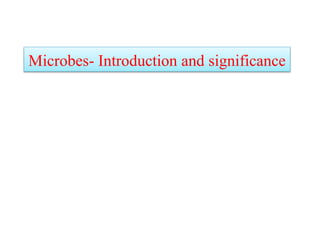
Microbes-Introduction and significance.pptx
- 1. Microbes- Introduction and significance
- 2. Discovery of Microbes •Microbiology is the study of living organisms of microscopic size. •The term microbiology was given by French chemist Louis Pasteur (1822-95). •The term microbe was first used by Sedillot (1878).
- 3. The Discovery Era In 384-322 Aristotle and others believed that living organisms could develop from non-living materials. In 13th century, Rogen Bacon described that the disease caused by a minute “seed” or “germ”. Robert Hooke, a 17th-century English scientist, was the first to use a lens to observe the smallest unit of tissues he called “cells.” Antony Van Leeuwenhoek Descriptions of Protozoa, basic types of bacteria, yeasts and algae. Father of Bacteriology and protozoology. In 1676, he observed and described microorganisms such as bacteria and protozoa as “Animalcules”. In 1878, the term microbe is used by Sedillot.
- 4. Transition Period •When microorganisms were known to exist, most scientists believed that such simple life forms could surely arise through spontaneous generation. •That is to say life was thought to spring spontaneously from mud and lakes or anywhere with sufficient nutrients. •This concept was so compelling that it persisted until late into the 19th century. •The main aspects were to solve the controversy over a spontaneous generation which includes experimentations mainly of Francesco Redi, John Needham, Lazzaro Spallanzani, and Nicolas Appert, etc,
- 5. The Golden Age • The Golden age of microbiology began with the work of Louis Pasteur and Robert Koch who had their own research institute. • More important there was an acceptance of their work by the scientific community throughout the world and a willingness to continue and expand the work. • During this period, we see the real beginning of microbiology as a discipline of biology. • Louis Pasteur is known as the “Father of Modern Microbiology / Father of Bacteriology.
- 6. Microbiology is the study of microorganisms Or microbes which is visible only with a microscope. The diverse group of organisms includes algae, archaea, bacteria, cyanobacteria, fungi, protozoa, viruses. History of microbiology starts in the 3rd century BC with Hippocrates recording ideas of infections and diseases. Distribution in Nature: Omnipresent: nearly everywhere in Nature. Grow where they get food moisture and temperature suitable for growth. Ie Air,Soil,water, Food we eat ,Surfaces of our body and inside alimentary canal.
- 7. Most of the microorganisms are harmless. 99% are good. Eg: Cyanobacteria (blue green algae) 1% are bad. Microbiology includes study of Bacteria Fungi Viruses Protozoa Algae. etc.
- 8. Archaea Archaea or Archaebacteria differ from true bacteria in their cell wall structure and lack peptidoglycans. They are prokaryotic cells with avidity to extreme environmental conditions. Based on their habitat, all Archaeans can be divided into the following groups: 1. Methanogens (methane-producing organisms), 2. Halophiles (archaeans that live in salty environments), 3. Thermophiles (archaeans that live at extremely hot temperatures), and 4. Psychrophiles (cold-temperature Archaeans). Archaeans use different energy sources like hydrogen gas, carbon dioxide, and sulphur. Some of them use sunlight to make energy, but not the same way plants do. They absorb sunlight using their membrane pigment, bacteriorhodopsin. This reacts with light, leading to the formation of the energy molecule adenosine triphosphate (ATP).
- 9. Bacteria: Size: 0.2-1.5 by 3-5 µm Characteristics: Prokaryotic Unicellular Simple Internal structure Grow on artificial laboratory media Reproduction
- 10. Significance: Some cause diseases Some perform role in natural cycling of elements and increase soil fertility Manufacture of valuable compounds in Industry Viruses : Size: 0.015-0.2 nm Important Characteristics: Do not grow on artificial media require living cells within which they reproduce
- 11. Obligate parasites Electron microscopy required to observe Practical significance Cause diseases in humans animals plants Also infect microorganisms Fungi (Yeasts) Size: 5.0-10.0 µm Important Characteristics: Eukaryotic Unicellular Grow on artificial laboratory media Reproduction asexual (cell division/ budding) or sexual Practical significance
- 12. Some cause diseases some are used as food supplements Manufacture of alcoholic beverages Fungi (Molds) Size: 2.0-10.0 µm by several mm Important Characteristics: Eukaryotic Multicellular Many distinctive structural features Cultivated on artificial laboratory media
- 13. Reproduction asexual or sexual. Significance: Decomposition of many materials. Industrial production of many chemicals like antibiotic's. Can cause diseases. Protozoa Size: 2.0-200 µm. Important Characteristics: Eukaryotic.
- 14. Unicellular Some cultivated on laboratory media while some are intracellular parasites Reproduction asexual or sexual Practical significance: Some cause diseases. Food for aquatic animals. Algae Size: 1.0 µm to several centimetres.
- 15. Important Characteristics: Eukaryotic. Unicellular or Multicellular. Photosynthetic. Most occur in aquatic environments. Reproduction asexual or Sexual. Practical significance: Production of food in aquatic environments. Source of food and in Pharmaceuticals but some produce toxic substances.